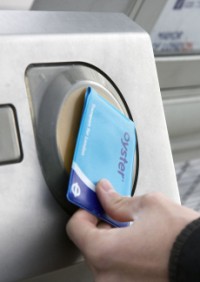Mobile phones and bank cards to replace tickets for travelling in London

London's commuters will be able to use their mobile phones and bank cards for "ticketless travel" across the metropolis, if Transport for London's plans come to fruition.

Thousands of London bus users already pay their fares using contactless bank cards instead of TfL Oyster cards, which have been widely used over the past decade. Users pay different charges for different London Underground zones, so that's a trickier proposition. It's even harder to handle train travel, where the various different companies charge a confusingly wide range of fares, depending on the time of travel, the train used, and who is travelling.
Almost everyone who lives in London, and millions of annual visitors, use London transport, so TfL's choices are extremely influential. Once TfL's systems come into common use, other businesses will try to exploit the same payment mechanisms. TfL could therefore drive the widespread adoption of systems such as contactless EMV (Europay, MasterCard and Visa) bank cards, Barclaycard's PayTag stickers, and the NFC (Near Field Communication) system already built into many smartphones.
According to Dave Birch, a digital money expert from Consult Hyperion, TfL's gates (or barriers) can already work with NFC phones, but the system is not currently switched on.
Consult Hyperion has been advising TfL on its strategy and implementation. It also acts as a consultancy for many of the leading suppliers of payment systems, including Barclaycard, MasterCard and Visa.
Birch says travellers will probably be able to use bank cards for tube travel by the end of this year. This will be possible thanks to back-end processing that limits each user's total spending on TfL tickets to the cost of the applicable one-day TravelCard. Oyster cards already do this, but they only work in London.
"Ideally, what you want is one national card like they have in the Netherlands," says Birch. "That's very difficult to do in the UK because you have so many [rail] franchises and so many ticket prices…."
With complex train fares, which often extend beyond London, users will be able to buy tickets using their smartphones. In fact, a week ago, O2 launched a TrainTravel smartphone app that does this on Apple iOS, Android and some BlackBerry mobile phones, regardless of network. The payment is made via the O2 Wallet.
Birch says: "The idea is terrific, but if I buy the ticket on my phone, I still have to go to the station to collect my [paper] ticket." This is needed to get through the station barriers and onto the train.
He envisages a system where people can use their mobile phones as tickets, without needing paper versions.
Barclaycard's PayTag is another option. Basically, PayTag is a Visa card that comes in the form of a sticker that you stick to your phone. It works without PINs with today's contactless card readers, including the ones used on London buses, for amounts up to £20. It solves the problem of not all smartphones supporting NFC (and Apple's iPhone is a laggard in this respect).
Tags also enable tourists to use the system. Birch says they could buy PayTags or TfL tags at the airport, stick them to their phones, and use them as contactless transport tickets. If they choose a tag supplied by a bank or credit card company, they should also be able to use them for other purchases. PayTags are already supported by McDonald's, Subway, Boots and other outlets.
Since they are actually bank cards, tags don't need battery power, and will continue to work even if the phone is dead.
It remains to be seen whether Oyster cards will be withdrawn, because they do have advantages. The Oyster card is a "stored value card", which means TfL passengers pre-load it with cash which they can then spend. TfL has their money before they even travel.
Most importantly, Oyster cards can be read very quickly: in 300 to 350 milliseconds, according to Consult Hyperion. According to a slide shown by Cubic at the Transport Ticketing 2013 Conference, bank card transactions peak at 545ms, with smaller peaks at 420ms and 490ms.
TfL needs to be able to get 26 users per minute through barriers at peak times, and that's a challenge for NFC. Last May, Shashi Verma, TfL's director of customer experience, told NFC Times: "I’d love it to work. But it doesn’t work [for Transport for London] right now."
Also, Oyster cards are anonymous, and many users will be aware that using a bank card will mean their movements can be tracked.
On March 27 2013, TfL announced that it had issued an OJEU (Official Journal of the European Union) notice for the £1 billion Electra contract, which will "take the Capital's transport ticketing systems into the next decade". Whoever wins it will be responsible for "the provision and maintenance of front and back office revenue collection systems for all of TfL's services, including approximately 4,000 retail outlets, and at National Rail stations where Oyster is accepted".
The Electra contract will be awarded in October 2014, with a 10-month transition period to take over from Cubic Transportation Systems (unless Cubic wins the bid). Whichever company is appointed to collect TfL's fares is in for some interesting times.